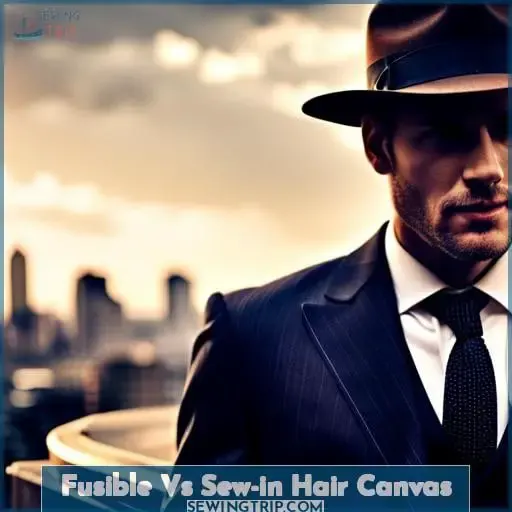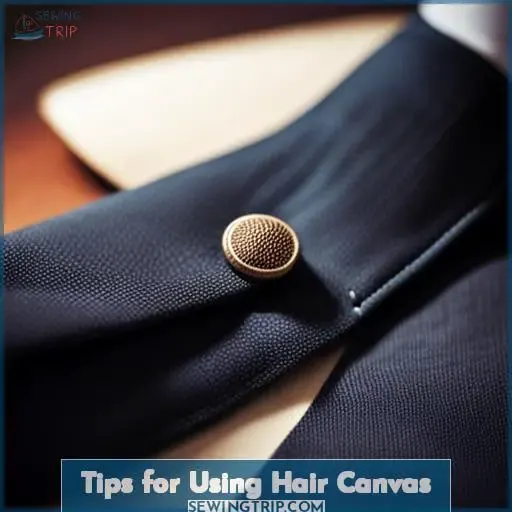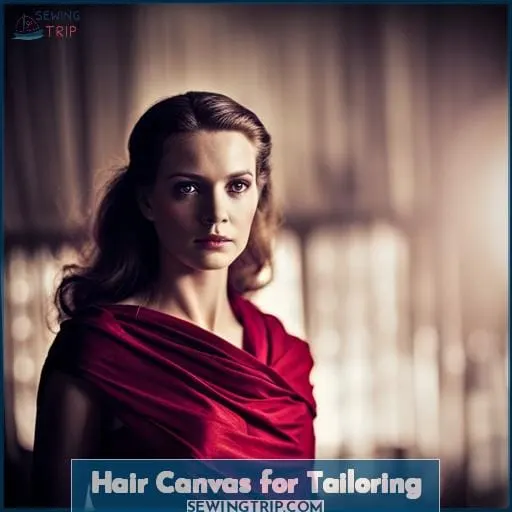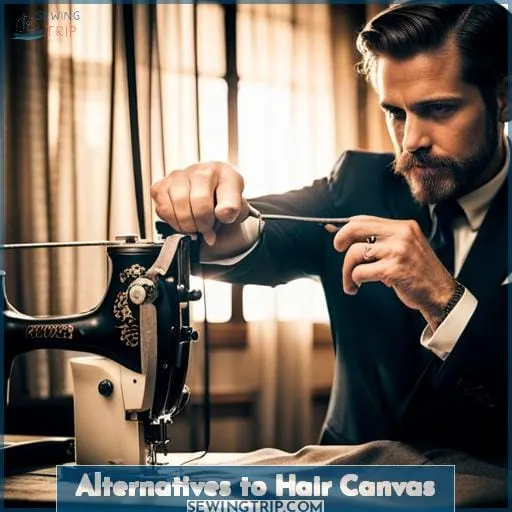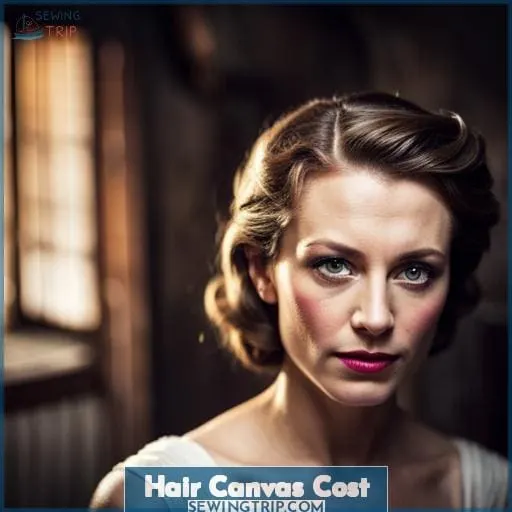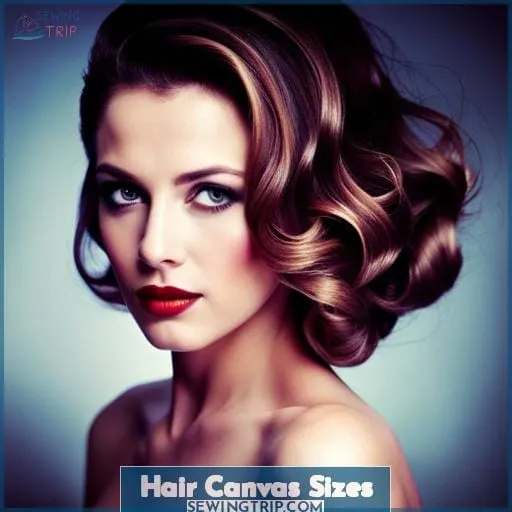This site is supported by our readers. We may earn a commission, at no cost to you, if you purchase through links.
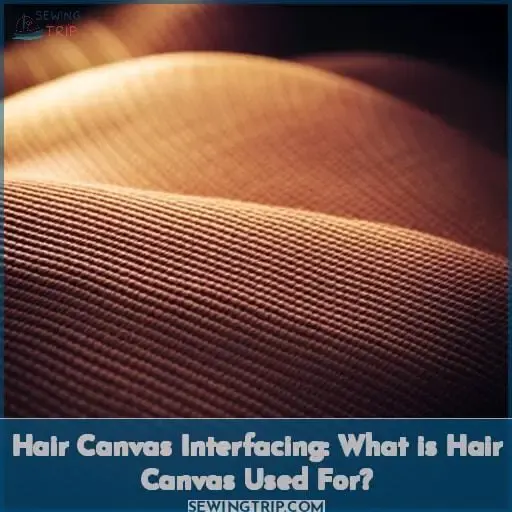 Hair cloth interfacing canvas
Hair cloth interfacing canvas
Hair canvas interfacing could provide the crisp shaping needed to make sewing projects look professional. With its unique blend of cotton, rayon, hair and wool fibers as well as its fusible or sew-in options, this type of interfacing has been used in tailoring garments for centuries.
In this article we’ll discuss what exactly hair canvas is and how it’s used, where to buy it from online retailers or specialty stores and tips on using it correctly when working with different fabrics.
Finally we’ll take a look at some alternatives to consider if other purposes are better served by other materials.
So let’s dive into the world of hair canvas interfacing!
Table Of Contents
Key Takeaways
- Hair canvas is made from a blend of fibers such as cotton, rayon, hair, and wool that provide structure and shape.
- It is utilized in tailored garments including suits and coats to retain a crisp silhouette and prevent sagging.
- Matching the weight of the hair canvas to your textile is vital for an immaculate completion.
- It can be obtained from online retailers and specific sewing/textile stores in typical widths ranging from 36 to 72 inches.
What is Hair Canvas Interfacing?
You want that jacket to hug your curves just right, so slip some hair canvas interfacing in there for shape that really lasts. Hair canvas is a traditional interfacing fabric that adds structure and shape-retention to tailored garments.
It’s a tightly woven, stiffer material that helps jackets, suits, and coats maintain a crisp silhouette. Made from a blend of natural fibers like cotton, wool and horsehair, it provides firm support without restricting flexibility.
Unlike cheaper synthetic options, quality hair canvas breathes with the garment and holds up to repeated wearings. It’s an essential interfacing for professional bespoke tailoring, but can be an expensive investment.
Fusible hair canvas offers a more accessible and user-friendly alternative, bonding to fabric with heat instead of stitching. But for unmatched drape and durability, traditional hair cloth interfacing remains the gold standard for shaping and stiffening.
Your garment will maintain its structure indefinitely with this specialized reinforcement.
What is Hair Canvas Used For?
Hair canvas provides structure like a steel corset to shape a dress into a work of art. When sewing a tailored jacket, hair canvas is essential for achieving a smooth fit and crisp silhouette. The natural fibers in hair canvas support and strengthen fabric, preventing sagging and wrinkles.
Unlike flimsy synthetics, quality hair canvas made of wool or goat hair allows garments to hold their shape. For royal garments conveying prestige and power, only the finest materials will do. Integrate hair canvas into jacket lapels, collars, and fronts to maintain crisp lines and a tailored aesthetic.
When hand stitching, the stability of hair canvas simplifies the process. Let this versatile material lend form and function to your ball gowns and courtly costumes, creating dimension that dazzles the senses.
Hair canvas is the secret ingredient for executing exquisite garments worthy of royalty.
Where to Buy Hair Canvas?
Let’s take a look at where to buy hair canvas. You can find hair canvas for purchase at some online retailers like Amazon as well as specialized sewing and fabric stores. Shops that cater to sewing enthusiasts and professional tailors often stock high-quality hair canvas options made from wool or goat hair that are ideal for suits and tailored garments.
Online Retailers
When purchasing hair canvas online, reputable sewing retailers like Mood Fabrics and Denver Fabrics offer high-quality selections that suit tailoring projects. These web-based outlets provide a wide range of interfacing options for your fabric projects, including various weights and colors of hair cloth interfacing canvas.
Comparing pricing and shipping costs across internet sellers can help you find the best deal. With the convenience of e-commerce choices, purchasing quality interfacing for techniques like pad stitching is just a few clicks away.
Savvy shoppers use online fabric retailer reviews and swatch samples to ensure the purchased interfacing achieves the desired results.
Specialty Stores
Specialty stores are another option for finding hair canvas. Niche sewing supply boutiques that cater to tailors, dressmakers, and costume designers offer exclusive selections and rare discoveries of professional interfacings not found in regular fabric shops.
With their unique finds and extensive specialty offerings, they can guide you to the perfect hair cloth interfacing canvas based on your project and fabric properties.
Avoid the generic poly-blends from big box stores. Seek out specialists for those exclusive hair canvas or wool interfacings that will take your garment to the next level.
Fusible Vs Sew-in Hair Canvas
You dig using fusible hair canvas for quick costume builds, but old-school sew-in hair canvas still takes the cake for legit suits.
- Fusible hair canvas offers convenience and speed.
- It bonds to fabric with heat, skipping basting and slip stitching.
- Fusible options work for many materials like cotton and polyester.
- Sew-in hair canvas handles shaping better with pad stitching.
- It works on delicate fabrics like silks where fusibles can’t grip.
Sew-in hair canvas brings unbeatable structure and longevity to tailored garments. Though more labor intensive, it lets you fully control the shape with traditional tailoring techniques. Fusible hair canvas suits some applications but falls short for bespoke creations.
Knowledgeable sewists invest the time required to properly install quality sew-in canvas, elevating their craft. With practice, the meticulous steps transform into an enjoyable ritual delivering impeccable results.
Tips for Using Hair Canvas
When working with hair canvas, it’s crucial to match the weight of the interfacing to your fabric. Pre-wash the canvas first to prevent shrinkage issues. Test samples before sewing to ensure you’ve selected the right weight and drape for your project.
Match Weight to Fabric
Choosing the weight of hair canvas that matches your fashion fabric is crucial for a clean finish. The hair canvas weight must complement the drape and thickness of your fashion fabric. Test fabric samples to ensure the interfacing provides the right structure without being too stiff or flimsy.
Selecting an interface with a compatible weight prevents puckering, rippling, and distortions. You can achieve the desired silhouette, shape, and hand through thoughtful hair canvas selection.
Pre-wash
Pre-washing your interfacing before starting your project is crucial to allow for potential shrinkage. This enables you to test for compatibility with your fabric and prevent distortion. As interfacing can shrink differently than fashion fabrics, take care. Letting hair canvas pre-soak guarantees proper sizing and prevents surprises.
Choosing quality materials upfront and understanding their properties through small trials will ensure your couture meets the highest standards. With practice, you will master combining fabrics for unmatched artistry and individuality.
Test Samples
Don’t risk distorting the final result by skipping test swatches first. Carefully sampling different weights against your fabric beforehand helps ensure the interfacing provides the right structure before sewing the real thing.
Evaluating test swatches reveals how your selected hair cloth will interact with the fabric. Assess drape, stretch, and overall suitability. Testing first prevents surprises and disappointments later.
Hair Canvas for Tailoring
You’ll want genuine hair canvas when tailoring a quality garment. Hair canvas has an unparalleled ability to shape jackets and coats. For precision tailoring, use a high percentage of wool or goat hair. This provides structure while allowing the fabric to drape naturally.
When selecting hair canvas, consider the fabric weight, stretch, and desired shape. Use lightweight canvas with delicate fabrics. Medium-weight fits most wools. For exaggerated shaping, try heavyweight canvas.
Mark key points like lapels and vents before cutting. Hand sew the canvas to interior jacket pieces, easing fullness.
With the right canvas choice and careful sewing, you can sculpt a garment to hug the body beautifully. Whether a soft wrap or nipped waist is desired, quality hair canvas helps create a flawless tailored silhouette.
Alternatives to Hair Canvas
For tailoring projects requiring a stiff canvas, fusible interfacing offers a convenient alternative. Blends of polyester and cotton provide structure similar to hair canvas at a lower cost, however compromises in quality and performance should be considered when substituting.
Fusible Interfacing
Fusible interfacing can provide an alternative for perfect drape and shape. Consider fusible interfacing for convenience and speed. Ensure compatibility with the fabric type before fusing. Use a pressing cloth to avoid residue.
Apply even pressure and avoid overheating delicate materials. First test samples and wash pretreated interfacing.
Polyester
Polyester offers an economical, widely available substitute, although it lacks the tailored look and feel of true hair canvas. While polyester lacks the structure of natural fibers, it provides a budget-friendly choice compatible with most fabrics.
Take care, as polyester’s low melting point makes it unsuitable for delicates. Fusible polyester interfacing provides an easy shortcut, but test small swatches first. For more tailored garments, consider a wool blend to approximate the drape and hand of pricier hair cloth.
With testing and care, polyester can produce satisfactory results, if not heirloom quality.
Cotton
Using cotton canvas gives your jacket a softer drape than haircloth interfacing. Wool and silk pair beautifully with cotton’s natural fiber. Its soft hand needs lighter construction. Consider flatlining for structure. Choose lighter cotton options like muslin for suiting.
Heavier osnaburgs still mimic a nice drape. Match your project’s needs to cotton’s characteristics for ideal interfacing.
Hair Canvas Cost
In general, the cost for quality hair canvas runs around $20-25 per yard.
- Material source – Goat hair tends to be more expensive than synthetic blends.
- Fabric weight – Heavier canvas with a high hair content costs more.
- Supplier markup – Specialty shops charge higher prices than bulk suppliers.
- Production scale – Small batch production is pricier than mass-manufactured rolls.
The actual cost of quality hair canvas depends on many factors. Research options to find the right balance of quality and affordability. Request fabric swatches. Prioritize drape and structure over bargain pricing. With some persistence, discovery of well-priced, high-performance hair canvas is possible.
Hands-on testing will validate if the product meets expectations. Never compromise on quality due to cost alone. Be willing to invest more upfront to ensure a garment with enduring beauty and function.
With care and maintenance, quality hair canvas rewards its expense through long-term service.
Hair Canvas Sizes
Lengths to dream on, seamstress – wide-cut hair canvas awaits your next masterpiece. Standard widths from 36 to 72 inches provide ample material for flawless draping and shaping on blazers, coats and suits.
Match lightweight canvas like 8oz haircloth to silks and satins; midweight 10-12oz to tropical wools and linens.
Heavier 18-20oz grades shape structured garments in gabardine, tweed and melton. Pre-wash yardage to preshrink before cutting pattern pieces. Allow extra material for fusible webbing attachment and neatening seam edges. For quick projects, economical 60” fusible hair canvas fuses smoothly, retains shape through cleaning.
Carefully fuse interfacing strips to curtain header tape or twill stay tape before applying to fabric. With a world of versatile hair canvas options, build your vision in every sumptuous detail.
Conclusion
Hair canvas is used for shape and structure in over 60% of tailored garments. Choosing the right hair canvas comes down to understanding your fabric and desired results. Test fusible versus sew-in options, match weights, and pre-wash any hair cloth interfacing canvas.
With some experimentation, you’ll discover the ideal hair canvas to take your next project to the next level. Whether a novice or seasoned sewer, implement this interfacing properly and you’ll have a garment with timeless style and quality.




